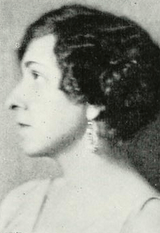Mildred Couper
Mildred Couper (December 10, 1887 in Buenos Aires, Argentina – August 9, 1974[1] in Santa Barbara, United States) was a prominent composer and pianist, and one of the first American musicians to experiment with quarter-tone music. She was based in Santa Barbara, California.
Mildred Couper | |
|---|---|
 Mildred Couper, from a 1933 publication. | |
| Born | Mildred Cooper December 10, 1887 Buenos Aires, Argentina |
| Died | August 9, 1974 Santa Barbara, California |
| Nationality | British, American |
| Occupation | Musician, composer |
Early life
Mildred Cooper was born in Buenos Aires, the daughter of Reginald Cooper and Harriet Hathaway Jacobs. Her father was born in England; her mother was born in Argentina to American-born parents.[2][3] She began her serious musical studies at the Williams Conservatory in Argentina, and pursued further training in Italy, Germany and France, where she studied piano with Moritz Moszkowski and composition with Nadia Boulanger.[4]
Career
Couper taught piano for nine years at the David Mannes Music School in New York. She moved with her children to California in 1927 and established a studio in Santa Barbara, where she started her experiments with two pianos by tuning the first a quarter tone higher than the second. This increased the normal 88 pitch levels to 176, expanding so the gamut by a quarter step to emphasize the character of the harmony.[5] Her first work in this medium was the ballet Xanadu (1930), which was performed in the production of Eugene O'Neill's Marco Millions in the Lobero Theatre. Mildred Couper also wrote incidental music for plays at the Lobero and also a dance-opera, And on Earth Peace, with libretto by Scottish-Argentine artist Malcolm Thurburn.[6]
Personal life
Mildred Cooper married American expatriate artist Richard Hamilton Couper in 1910, and they had two children, Clive (1913-2004) and Rosalind (1915-2016), both born in Rome. At the outbreak of World War I the Coupers moved to New York City. She was widowed soon after, when her husband died during the 1918 influenza pandemic. She died in Santa Barbara, California, in 1974, aged 86 years. Her papers are archived in the Department of Special Collections at the University of California, Santa Barbara.[7]
References
- "California Death Index, 1940-1997". FamilySearch. Retrieved 26 April 2016.
- Who's who in music and dance in Southern California. University of California Libraries. Hollywood : Bureau of Musical Research. 1933. p. 181.CS1 maint: others (link)
- "Person Page: Mildred Cooper". The New England Ball Project. Retrieved 2020-04-19.
- Nicole V. Gagné, Historical Dictionary of Modern and Contemporary Classical Music, p.66, Scarecrow Press (2011), ISBN 0810867656
- Maurice Hinson, Music for More Than One Piano: An Annotated Guide, p. 42, Indiana University Press (2001), ISBN 0253214572
- Catherine Parsons Smith, "Mildred Couper", ed. L. Macy, on Grove Music Online (subscription access). Accessed November 27, 2006
- "Mildred Couper Papers, 1920s-1970 (PA Mss 45)". UCSB Library. 2011-08-19. Retrieved 2020-04-19.
